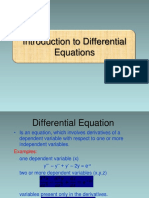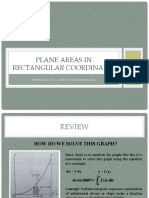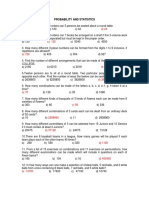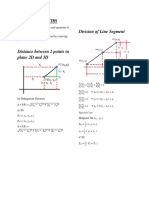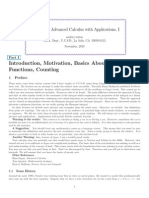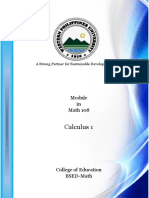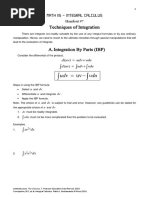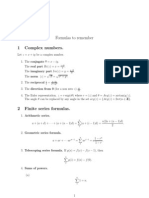Analytic Geometry & Calculus
Uploaded by
anonreteeCopyright:
Available Formats
Analytic Geometry & Calculus
Uploaded by
anonreteeCopyright
Available Formats
Share this document
Did you find this document useful?
Is this content inappropriate?
Copyright:
Available Formats
Analytic Geometry & Calculus
Uploaded by
anonreteeCopyright:
Available Formats
Analytic Geometry
Kristina S. Camsol
Distance between two points in a plane
d= x
2
x
1
2
+ y
2
y
1
2
Slope
m=
y
x
=
y
2
y
1
x
2
x
1
Parallel Lines
m
1
=m
2
Perpendicular Lines
m
1
=
1
m
2
Angle between two lines
tan =
m
2
m
1
1+m
1
m
2
m
1
= slope of equation 1
m
2
= slope of equation 2
Example:
Find the angle (in degrees) between the two lines:
6x-y+8=0
-3x-11y+10=0
Solution:
6x-y+8=0 eq. 1
-3x-11y+10=0 eq. 2
Soln:
eq. 1 y=6x+8 ; m
1
=6
eq. 2 y=
3
11
x+10 ; m
2
=
3
11
tan =
3
11
6
1+
3
11
6
= 84.2
Distance between a point and a
line
d=
Ax
1
+By
1
+C
A
2
+B
2
Example:
Find the distance from the point (-2,-1) to the line 3x-4y=12.
Gen. equation of a line:
Ax + By + C = 0
Solution:
3x-4y-12=0 ; A = 3, B = -4, C = -12
d=
3 2 + 4 1 + 12
3
2
+ 4
2
= 2.8
d = 2.8
Distance between two parallel lines
d=
C
1
C
2
A
2
+B
2
Example:
Find the distance between 3x+4y+5=0 and 3x+4y+2=0.
Soln:
d=
52
3
2
+4
2
d = 0.6
Area of a polygon using the coordinates of
its vertices
Coordinates must be arranged in the matrix in a counter-clockwise
direction based on the Cartesian plane.
x
1
x
2
x
3
y
1
y
2
y
3
A=
1
2
x
1
y
2
+x
2
y
3
+x
3
y
1
y
1
x
2
+y
2
x
3
+y
3
x
1
Example:
(4,10), (9,7), (11,2), (2,2)
Arrange counter-clockwise direction on the cartesian plane:
(11,2), (9,7), (4,10), (2,2)
A = 0.5{[(11)(7)+(9)(10)+(4)(2)+(2)(2)]-
[(2)(9)+(7)(4)+(10)(2)+(2)(11)]}
A = 45.5
Circle
General Equation
Ax
2
+Cy
2
+Dx+Ey+F=0
Standard Equations
x
2
+y
2
=r
2
xh
2
+ yk
2
=r
2
h=
D
2A
k=
E
2A
Circle
Example:
What is the distance between the center of the circles x
2
+y
2
+2x+4y-
3=0 and x
2
+y
2
-8x-6y+7=0?
Soln:
A
1
=1, D
1
=2, E
1
=4 A
2
=1, D
2
=-8, E
2
=-6
C
1
(-1,-2) Using the distance formula, the answer
C
2
(4,3) would be approximately 7.07 units.
h
1
=
2
2(1)
= 1 k
1
=
4
2(1)
= 2 h
2
=
(8)
2(1)
=4 k
2
=
(6)
2(1)
= 3
Parabola
Ax
2
+Dx+Ey+F=0
Cy
2
+Dx+Ey+F=0
Standard Equations
y
2
=4ax
yk
2
=4a xh
x
2
=4ay
xh
2
=4a yk
Vertex is at the point (h,k).
Focus is the point (inside the parabola) a units from the vertex.
Directrix is the line (outside the parabola) a units from the vertex.
Parabola
Example:
What is the equation for the parabola with focus (-2,-2) and
directrix y=4?
Soln:
midpoint=
y
1
+y
2
2
=
2+4
2
=1
V(-2,1)
a = 4-1 = 3
(x-h)
2
= -4a(y-k)
(y-1) =
1
4(3)
(x+2)
2
y1 =
1
12
x+2
2
Parabola
Eccentricity is the ratio of the distance to the
focus to the distance to the directrix
e=
f
d
, since f = d
e=1
Latus rectum is a line that passes through the
focus and perpendicular to the axis of the conic
LR=4a
Parabola
For horizontal axis: For vertical axis:
Cy
2
+Dx+Ey+F=0
h=
E
2
4CF
4CD
k=
E
2C
a=
E
4A
Ay
2
+Dx+Ey+F=0
h=
D
2A
k=
D
2
4AF
4AE
a=
E
4A
Ellipse
Ellipse General Equation
Ax
2
+Cy
2
+Dx+Ey+F=0
b = semi-minor
a = semi-major
e < 1
d
1
+ d
2
= 2a
e=
c
a
LR
LR=
2b
2
a
Ellipse Standard Equations
MA is horizontal MA is vertical
x
2
a
2
+
y
2
b
2
=1
x
2
b
2
+
y
2
a
2
=1
xh
2
a
2
+
yk
2
b
2
=1
xh
2
b
2
+
yk
2
a
2
=1
Find the length of the latus rectum of the following ellipse:
25x
2
+9y
2
-300x-144y+1251=0
Soln:
25x
2
-300x+9y
2
-144y+1251=0
25(x
2
-12x)+9(y
2
-16y)+1251=0
25(x
2
-12x)+9(y
2
-16y)=-1251
25(x
2
-12x+36)+9(y
2
-16y+64)=-1251+900+576
25(x-6)
2
+9(y-8)
2
=225
A
a
x6
2
3
2
+
y8
2
5
2
=1
LR=
2 3
2
5
=3.6
Hyperbola
Hyperbola General Equation
Ax
2
Cy
2
+Dx+Ey+F=0 vertical
Cy
2
Ax
2
+Dx+Ey+F=0 horizontal
Hyperbola
Hyperbola Standard Equations
xh
2
a
2
yk
2
b
2
=1
yk
2
a
2
xh
2
b
2
=1
From the illustration:
e=
c
a
e > 1
c
Hyperbola
Example:
From the hyperbola y
2
/25 x
2
/9 = 1. Give the
vertices, foci and equations of asymptotic lines.
Hyperbola
Soln:
a = 5 b = 3 c = 5.8
V
1
(0,-5) V
2
(0,5)
F
1
(0,-5.8) F
2
(0,5.8)
y = -(5/3)x y = (5/3)x
Polar Coordinates
Polar coordinates (r,)
Rectangular coordinates (x,y)
Relationship:
x = rcos y = rsin
r
2
= x
2
+ y
2
Polar Coordinates
Example:
What is (13, 22.6) in Cartesian Coordinates?
r = 13, = 22.6
x = rcos y = rsin
x = (13)(cos22.6) y = (13)(sin22.6)
x ~ 12 y ~ 5
(12,5)
Differential & Integral
Calculus
Kristina S. Camsol
Calculus Latin calx stone, and Greek chalis limestone
Gottfried Wilhelm von Leibniz & Isaac Newton considered as the
founders of todays calculus.
Limit Theorems
1. If lim
xa
f x =L exists, then it is unique.
2. lim
xa
f x +g x = lim
xa
f x + lim
xa
g x =L+K
3. lim
xa
f x g x = lim
xa
f x lim
xa
g x =LK
4. lim
xa
f x g x = lim
xa
f x lim
xa
g x =L K
5. lim
, 0
6. lim
1
=
1
, 0
7. lim
xa
= lim
xa
8. lim
xa
= lim
xa
f x
lim
xa
f x =L lim
xa
g x =K
Limit Theorems
9. lim
xa
= lim
xa
10. If f(x) is a polynomial function, lim
xa
=
11. lim
= lim
, > 1
12. If f(x) h(x) g(x), and if
lim
xa
f x =L= lim
xa
g(x) , then lim
xa
h x =L
Limit Theorems
If f(x) is a polynomial, and lim
+
= = lim
, then the
limit exists at L.
But if lim
+
= lim
, then the limit does not exist.
Let h be defined by
h x =
4x
2
if x1
2+x
2
if x>1
lim
x1
4x
2
=3 lim
x1+
2+x
2
=3
lim
x1
h(x) = lim
x1+
h(x)
The limit if h(x) exists at 3.
h(x)=4-x
2
h(x)=2+x
2
Let f(x) be defined by
f x =
6x
2
if 0x<2
x1 if 2x4
lim
x2
6x
2
=2 lim
x2+
x1 =1
lim
x2
f(x) lim
x2+
f(x)
The limit does not exist.
Special Limits
1. lim
0
= 1
2. lim
0
1
= 0
3. lim
1 +
1
=
4. lim
1 +
1
=
LHpitals Rule
If f(x) and g(x) are two functions such that
lim
= 0 and lim
= 0
Then lim
()
()
has the indeterminate form 0/0 at a.
LHpitals Rules states that
lim
()
()
= lim
()
()
LHpitals Rule
Let f(x) be defined by sinx and g(x) be x.
f(x) = cosx and g(x) = 1.
lim
0
()
()
=lim
0
sin
= lim
0
cos
1
= 1
LHpitals Rule
Let f(x) be defined by x
2
-1 and g(x) be x
2
+3x-4.
f(1)= 1
2
-1 = 0
g(1)= 1
2
+3(1)-4 = 0
lim
1
()
()
= lim
1
2
1
2
+3 4
lim
1
( +1)( 1)
( +4)( 1)
= lim
1
+1
+4
= 0.4
LHpitals Rule
f(x) = x
2
-1 f(x)=2x
g(x) = x
2
+3x-4 g(x)=2x+3
lim
x1
f(x)
g(x)
= lim
x1
2x
2x+3
=0.4
Derivatives
A derivative of a function expresses its
rate of change
A. Algebraic Functions
1.
dc
dx
=0
2.
d
dx
u+v =
du
dx
+
dv
dx
3.
d
dx
uv =u
dv
dx
+v
du
dx
4.
d
dx
u
v
=
v
du
dx
u
dv
dx
x
2
5.
d
dx
u
n
=nu
n1
du
dx
6.
d
dx
u
n
=
du
dx
n u
n
7.
d
dx
u
c
=
1
c
du
dx
8.
d
dx
c
u
=
c
du
dx
u
2
Derivatives
B. Exponential Functions
9.
d
dx
a
u
=a
u
ln a
du
dx
10.
d
dx
e
u
=e
u
du
dx
C. Logarithmic Functions
11.
d
dx
log
a
u =
log
a
e
du
dx
u
12.
d
dx
log
10
u =
log
10
e
du
dx
u
13.
d
dx
ln u =
du
dx
u
D. Trigonometric Functions
14.
d
dx
sin u = cos u
du
dx
15.
d
dx
cos u = sin u
du
dx
16.
d
dx
tan u = sec
2
u
du
dx
17.
d
dx
cot u = csc
2
u
du
dx
18.
d
dx
sec u =sec u tan u
du
dx
19.
d
dx
csc u = csc u cot u
du
dx
Maxima & Minima
First
Derivative
Second
Derivative
Behavior
Maximum
Point
0 Negative Concave
Downward
Minimum
Point
0 Positive Concave
Upward
Point of
Inflection
0
Maxima & Minima
Find two nonnegative numbers whose sum is 12 such that their
product is an absolute maximum.
Soln:
Let x and y be the two nonnegative numbers
x+y=12
f(x)=xy
f(x)=x(12-x)
f(x)=12-2x
Let f(x)=0
12-2x=0
x=6
Maxima & Minima
Find the area of the largest rectangle having two vertices on the x-axis and two
vertices on or above the x-axis and on the parabola y = 9 x
2
.
Soln:
A = 2xy
y = 9 x
2
A = f(x) = 2x(9 x
2
)
f(x) = 18x 2x
3
f(x) = 18 6x
2
f(x) = 0
6x
2
= 18
x = 1.732
A = 2(x)(9 x
2
)
A = 2(1.732)(9 1.732
2
)
A = 20.785
Implicit Differentiation
x
2
+ y
2
= 9 2xdx + 2ydy = 0
y= 9x
2
= 9x
2
1
2
2ydy = -2xdx
y=
1
2
9x
2
1
2
2x
2ydy
2ydx
=
2xdx
2ydx
y
=
x
9x
2
dy
dx
=
x
y
dy
dx
=
x
9x
2
Implicit Differentiation
Find the first derivative of x
3
+ y
3
= 8xy.
x
3
+ y
3
= 8xy
3x
2
dx + 3y
2
dy = 8[xdy+ydx]
3x
2
dx + 3y
2
dy = 8xdy + 8ydx
3y
2
dx 8xdy = 8ydx 3x
2
dx
(3y
2
8x)dy = (8y 3y
2
)dx
3y
2
8x dy
3y
2
8x dx
=
8y3y
2
dx
3y
2
8x dx
dy
dx
=
8y3y
2
3y
2
8x
Related Rates
An airplane is flying parallel to the ground at an altitude of 2 km and at a speed
of 4.5 km/min. If the plane flies directly over the Statue of Liberty, at what rate is
the line-of-sight distance between the plane and the statue changing 20 sec later?
Soln:
use Pythagorean theorem
c
2
=a
2
+b
2
a = 2
b = (4.5 km/min)(1 min/60 s)(20 s)
= 1.5 km
c = 2.5
Related Rates
From Pythagorean theorem,
c
2
= a
2
+ b
2
The first derivative would be 2c
dc
dt
=2a
da
dt
+2b
db
dt
da
dt
=0
db
dt
=4.5
dc
dt
=?
Using the first derivative of the theorem
(2.5)
dc
dt
= (2)(0) + (1.5)(4.5)
dc
dt
=2.7 km/min
Related Rates
A ladder is 25 ft long and leaning against a vertical wall. The bottom of the ladder is
pulled horizontally away from the wall at 3 ft/s. We wish to determine how fast the
top of the ladder is sliding down the wall when the bottom is 15 ft from the wall.
Soln:
From Pythagorean theorem,
c = 25, b = 15 c
dc
dt
=a
da
dt
+b
db
dt
a = 20
dc
dt
=0 (25)(0) = (20)(
da
dt
)+(15)(3)
db
dt
=3
da
dt
=2.25 ft/s
da
dt
=?
The negative sign denotes the direction to which the top of the ladder is sliding.
Additional Applications
If a closed tin can of volume 60 in
3
is to be in the form of a right circular cylinder, find the base
radius of the can if the least amount of tin is to be used in its manufacture.
Soln:
SA = 2rh + 2r
2
V = r
2
h = 60
h=
60
r
2
S(r) = 2r
60
r
2
+2r
2
S(r) =
120
r
+2r
2
S(r) =
120
r
2
+4r
S(r) = 0
120
r
2
+4r=0
r=
30
3
~2.12
Integration
A. Basic Integrals
1. du = u+C
2. adu = au+C
3. u
n
du =
u
n+1
n+1
+C , n1
4.
du
u
= ln u +C
B. Exponential & Logarithmic Functions
5. e
u
du = e
u
+C
6. a
u
du =
a
u
ln a
+C
7. ue
u
du = e
u
u1 +C
8. ln u du = u ln u u+C
9.
du
u ln u
= ln ln u +C
By parts
udv = uv vdu
Integration
Integration by parts
udv =uv vdu
Let u = f(x) , v = g(x)
du = f(x), dv = g(x)
Example:
x ln x dx
u = lnx, dv = xdx
du =
dx
x
, v =
x
2
2
+C
ln x xdx = ln x
x
2
2
+C
x
2
2
+C
dx
x
=
1
2
x
2
ln x +Cln x
1
4
x
2
Cln x +C
=
1
2
x
2
ln x
1
4
x
2
+C
Integration
Integration by other substitution techniques
x
5
x
2
+4dx
Let z = x
2
+4, z
2
= x
2
+ 4, 2zdz = 2xdx
x
5
x
2
+4dx = x
2
2
x
2
+4 (xdx)
= z
2
4
2
(z)(zdz)
= z
6
8z
4
+16z
2
dz
=
1
7
z
7
8
5
z
5
+
8
3
z
3
+C
=
1
105
z
3
15z
4
168z
2
+560 +C
=
1
105
2
+4
3
2
15
2
+ 4
2
168
2
+ 4 + 560 +
=
1
105
x
2
+4
3
2
15x
4
48x
2
+128 +C
Application of Integrals
Area
Centroid
Volume
Work
=
= = =
2
2
=
=
1
2
= ()
2
= ()
2
()
2
Vertical strip Horizontal strip Polar coordinates
Area
Example:
y
2
= 2x 2 & y = x 5
Let f(x) = (2x-2)
1/2
g(x) = x 5
Point/s of intersection
2x2
1
2
=x5
Square both sides
2x 2 = x
2
10x + 25
x
2
12x + 27 = 0
x
1
= 3 x
2
= 9
y
1
= - 2 y
2
= 4
A= ydx
x
2
x
1
A
2
= 2x2 x5 dx
9
3
A
2
=
38
3
A
1
A
2
Area
A= ydx
x
2
x
1
A
1
= 2x2 2x2 dx
3
1
A
1
=
16
3
A = A
1
+ A
2
=
16
3
+
38
3
A = 18
A
1
A
2
Area
Using horizontal strip
A= xdy
y
2
y
1
f(y) = (y
2
+ 2)
g(y) = y + 5
Using the limits from the previous
solution:
A= y+5
1
2
y
2
+2
4
2
dy
A = 18
Centroid
=
=
1
2
=
1
2
()
2
Centroid
Find the centroid of the first quadrant region bounded by the curve y
2
= 4x, the x
axis, and the lines x = 1 and x = 4.
A= 4x dx
4
1
A =
28
3
x=
x 4x dx
4
1
28
3
=
93
35
y=
1
2
4x 4x dx
4
1
28
3
=
45
28
Centroid =
93
35
,
45
28
,
Centroid
2. Find the centroid of the region bounded by the curves y = x
2
and y = 2x+3.
A= 2x+3 x
2
3
1
dx
A =
32
3
x=
x 2x+3 x
2
dx
3
1
32
3
=1
y=
1
2
2x+3 x
2
2
dx
3
1
32
3
=
17
5
Centroid = 1,
17
5
,
Volume
Volume of a Solid
Volume of a disk
Volume of a Washer
=
= ()
2
= ()
2
()
2
Volume
Volume of a Solid
Example: Find the volume of
A(x) = r
2
V= r
2
dx
h
0
V=r
2
x0
V= r
2
h
=
Volume
Volume of a disk
Determine the volume of the solid obtained by rotating the region bounded by
y = x
2
-4x+5, x=1, x=4, and the x axis
about the x axis.
V= x
2
4x+5
2
dx
b
a
V=
78
5
= ()
2
Volume
Volume of a washer
Determine the volume of the solid obtained by rotating the portion of the region
bounded by y
3
= x and y =
x
4
about the y axis.
Soln:
f(y) = 4y
g(y) = y
3
V= 4y
2
y
3
2
dy
2
0
V =
512
21
= ()
2
()
2
Work
=
A particle is moving along the x axis under the action of a force of f(x) pounds when the
particle is x feet from the origin. If f(x) = x
2
+ 4, find the work done as the particle moves
from the point x = 2 to the point x = 4.
W= f x dx
4
2
W= (x
2
+4)dx
4
2
W=
1
3
x
3
+4x
4
2
W = 26
2
3
Work
Hookes Law states that if a spring is stretched x units beyond its natural length, but
within its elastic limit, it is pulled back with a force of kx units, where k is a constant
dependent on the material and size of the spring.
A spring has a natural length of 14 cm. If a force of 500 dynes is required to keep the
spring stretched 2 cm, how much work is done in stretching the spring from its
natural length to a length of 18 cm?
By Hookes Law,
f(x) = kx W= 250xdx
4
0
f(2) = 500 W=
250
2
x
2
4
0
500 = k(2) W = 2000
k = 250
Multiple Integrals
f x,y dA
= f x,y dy
y
2
y
1
dx
x
2
x
1
Evaluate 3y2x
2
dA
R
if R is the region consisting of all points (x,y) for which
-1 x 2 and 1 y 3.
3y2x
2
dA
R
= 3y2x
2
dx
2
1
dy
3
1
= 3yx
2
3
x
3
2
1
dy
3
1
= 3y 2 1
2
3
2
3
1
3
dy
3
1
= 9y6 dy
3
1
=
9
2
y
2
6y
3
1
=
9
2
3
2
1
2
6 31
= 24
Multiple Integrals
V=f r, rdrd
R
Find the volume of the solid in the first octant bounded by the cone z = r and the cylinder r =
3sin.
z = f(r,) = r
V= r
2
drd
R
V= r
2
dr
3sin
0
d
2
0
V=
1
3
r
3
3sin
0
d
2
0
V=9 sin
3
d
2
0
V= 9 cos +3 cos
3
2
0
V = 6
sin
3
= 1cos
2
sin
Multiple Integrals
Moment of Inertia
=
2
,
=
2
,
End of Discussion
Thank You!
You might also like
- Counting Principles, Permutations & CombinationsNo ratings yetCounting Principles, Permutations & Combinations19 pages
- Parametric Equations & Polar CoordinatesNo ratings yetParametric Equations & Polar Coordinates80 pages
- Solutions To Integration by Partial FractionsNo ratings yetSolutions To Integration by Partial Fractions22 pages
- MCQ in Differential Calculus (Limits and Derivatives) Part 1 - Math Board ExamNo ratings yetMCQ in Differential Calculus (Limits and Derivatives) Part 1 - Math Board Exam13 pages
- MODULE 4 Part 2-Integral Calculus - Updated100% (1)MODULE 4 Part 2-Integral Calculus - Updated13 pages
- Plane Areas in Rectangular Coordinates: Prepared By: Keren TangarorangNo ratings yetPlane Areas in Rectangular Coordinates: Prepared By: Keren Tangarorang38 pages
- Problems Quiz PROB and STAT CHE With Answer KeyNo ratings yetProblems Quiz PROB and STAT CHE With Answer Key2 pages
- Solving Systems of Equations: MATH 15-1 Linear Algebra Week 2No ratings yetSolving Systems of Equations: MATH 15-1 Linear Algebra Week 253 pages
- Math 203: Number Theory: Alberto D. Yazon, PHDNo ratings yetMath 203: Number Theory: Alberto D. Yazon, PHD56 pages
- Module in Analytic Geometry and Conic SectionCalculus1No ratings yetModule in Analytic Geometry and Conic SectionCalculus164 pages
- Module 1 Lesson 2 - Equivalent Systems Elementary Row OperationsNo ratings yetModule 1 Lesson 2 - Equivalent Systems Elementary Row Operations8 pages
- Royal Colleges of Science and Management Inc.: College Algebra (MATH 1) First Semester AY: 2022-2023100% (1)Royal Colleges of Science and Management Inc.: College Algebra (MATH 1) First Semester AY: 2022-20236 pages
- Differentiation of Algebraic Functions With Solutions (Continuation) Ol61No ratings yetDifferentiation of Algebraic Functions With Solutions (Continuation) Ol6114 pages
- (English (Auto-Generated) ) Andrew Tate BEFORE He Was Famous. (FULL Interview) (DownSub - Com)No ratings yet(English (Auto-Generated) ) Andrew Tate BEFORE He Was Famous. (FULL Interview) (DownSub - Com)169 pages
- Metals: Charpy Impact Properties of Hydrogen-Exposed 316L Stainless Steel at Ambient and Cryogenic TemperaturesNo ratings yetMetals: Charpy Impact Properties of Hydrogen-Exposed 316L Stainless Steel at Ambient and Cryogenic Temperatures14 pages
- Yale Global King A-Frame Wire Rope Hoist 2014 Sept 11817505 Rev ABNo ratings yetYale Global King A-Frame Wire Rope Hoist 2014 Sept 11817505 Rev AB52 pages
- Cambridge IGCSE: Combined Science 0653/22No ratings yetCambridge IGCSE: Combined Science 0653/2216 pages
- GR-4/UN/V2: Common To Emergency Luminaire Converters Technical SpecificationsNo ratings yetGR-4/UN/V2: Common To Emergency Luminaire Converters Technical Specifications3 pages
- Brown, S. L. and Eisenhardt, K. M. (1997)No ratings yetBrown, S. L. and Eisenhardt, K. M. (1997)34 pages
- 5.12.5 Details of Compression-Ring Regions 5.12.5.1No ratings yet5.12.5 Details of Compression-Ring Regions 5.12.5.116 pages
- CUET_UG_2024_English_Question_Paper_with_Answer_Key_101_E_SET_BNo ratings yetCUET_UG_2024_English_Question_Paper_with_Answer_Key_101_E_SET_B17 pages
- Job Hazard Analysis Engineering Site Inspection1No ratings yetJob Hazard Analysis Engineering Site Inspection15 pages
- MCQ in Differential Calculus (Limits and Derivatives) Part 1 - Math Board ExamMCQ in Differential Calculus (Limits and Derivatives) Part 1 - Math Board Exam
- Plane Areas in Rectangular Coordinates: Prepared By: Keren TangarorangPlane Areas in Rectangular Coordinates: Prepared By: Keren Tangarorang
- Solving Systems of Equations: MATH 15-1 Linear Algebra Week 2Solving Systems of Equations: MATH 15-1 Linear Algebra Week 2
- Module in Analytic Geometry and Conic SectionCalculus1Module in Analytic Geometry and Conic SectionCalculus1
- Module 1 Lesson 2 - Equivalent Systems Elementary Row OperationsModule 1 Lesson 2 - Equivalent Systems Elementary Row Operations
- Royal Colleges of Science and Management Inc.: College Algebra (MATH 1) First Semester AY: 2022-2023Royal Colleges of Science and Management Inc.: College Algebra (MATH 1) First Semester AY: 2022-2023
- Differentiation of Algebraic Functions With Solutions (Continuation) Ol61Differentiation of Algebraic Functions With Solutions (Continuation) Ol61
- (English (Auto-Generated) ) Andrew Tate BEFORE He Was Famous. (FULL Interview) (DownSub - Com)(English (Auto-Generated) ) Andrew Tate BEFORE He Was Famous. (FULL Interview) (DownSub - Com)
- Metals: Charpy Impact Properties of Hydrogen-Exposed 316L Stainless Steel at Ambient and Cryogenic TemperaturesMetals: Charpy Impact Properties of Hydrogen-Exposed 316L Stainless Steel at Ambient and Cryogenic Temperatures
- Yale Global King A-Frame Wire Rope Hoist 2014 Sept 11817505 Rev ABYale Global King A-Frame Wire Rope Hoist 2014 Sept 11817505 Rev AB
- GR-4/UN/V2: Common To Emergency Luminaire Converters Technical SpecificationsGR-4/UN/V2: Common To Emergency Luminaire Converters Technical Specifications
- 5.12.5 Details of Compression-Ring Regions 5.12.5.15.12.5 Details of Compression-Ring Regions 5.12.5.1
- CUET_UG_2024_English_Question_Paper_with_Answer_Key_101_E_SET_BCUET_UG_2024_English_Question_Paper_with_Answer_Key_101_E_SET_B












